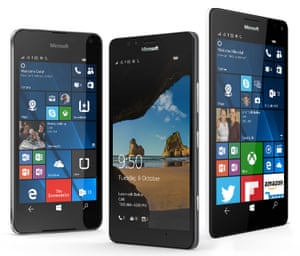Is it still worth buying a Windows phone?
Jack Schofield
Mike is a happy Windows smartphone user and wants to upgrade to the latest operating system. Is this wise, or is the phone going the way of the BlackBerry?
I’ve been using a Microsoft Lumia 640 for the past couple of years and like it a lot. It works well with OneDrive and other Microsoft stuff, and was excellent value too! Looking to upgrade to Windows 10 Mobile, I see there is no longer much choice of phones. I fancy the Lumia 650 and could splash out on a 950, but is this wise?
I had an Android phone before that, which gradually ground to a halt, and my daughter uses iPhones, but they aren’t for me. I’m happy with Windows phones, but what’s happening with them? Will they go the way of BlackBerry? Mike
Microsoft hasn’t launched a new Windows smartphone model for more than a year. However, it hasn’t given up on its smartphone operating system, so there may still be smartphones from other manufacturers. In fact, the best Windows 10 smartphone you can buy today, the HP Elite X3, is a third-party device.
Fortunately, you don’t have to buy a new phone to run Windows 10. Your Lumia 640 shipped with Windows 8.1 v2 (aka Denim), but it should run Windows 10 reasonably well, and Microsoft provides a free upgrade online.
The free upgrade also works with the Lumia 1520, 930, 830, 735, 640XL, 635, 535 and 435 smartphones. In fact, you could go one step further and enrol in the Windows Insider test program. This offers Windows 10 free on a wider range of hardware, including the Alcatel OneTouch Fierce XL, Xiaomi Mi4 and several BLU Win smartphones.
Ideally, installing and updating Windows 10 should enable you to keep using your current phone until we see what happens with Qualcomm’s Snapdragon 835 towards the end of this year and in early 2018.
The future is Snapdragon
In December, Microsoft said it was going to release a full version of Windows 10 for the fast eight-core Snapdragon 835 processor. Unlike earlier Windows phones and Windows RT tablets, this will run traditional Windows software, such as Adobe Photoshop, as well as Windows Store apps.
Traditional Windows software is written for Intel x86 processors, not for the ARM chips used in most smartphones. However, new devices based on the Snapdragon 835 will “transpile” binary Intel code into ARM code on the fly via a sort of emulation layer.
This approach is similar to the FX!32 that Digital Equipment Corporation used to run Windows programs on its Alpha processor in 1996. It’s also like Transitive’s QuickTransit program, which Apple licensed to run old Mac software when it switched from IBM PowerPC to Intel processors. (Apple called it Rosetta.)
Like other Snapdragon chips, the 835 is designed for mobile phones such as Sony’s Xperia XZ, so it includes LTE and Bluetooth communications. Microsoft aims to enable PC manufacturers to create connected Windows 10 laptops with all-day battery life, but the 835 could power Windows 10 smartphones and Microsoft HoloLens headsets as well.
Microsoft already has Continuum, which enables a Windows 10 smartphone to provide a PC-like interface on a large screen display, but that only works with apps. I’d buy a full Windows 10 smartphone just to get the same operating system on all my devices: desktop, laptop, tablet and smartphone.
Ecosystem wars

You say that your Lumia 640 “works well with OneDrive and other Microsoft stuff”. Microsoft wants Apple iPhone and Android users to say exactly the same thing.
Last week, Microsoft announced plans for the next major version of Windows 10, the Fall Creators Update, at its developers’ conference in Seattle. This includes new features to enable “Windows experiences [to] move with you across Windows, iOS, and Android”. In particular, Microsoft is integrating Cortana, its intelligent assistant, into these operating systems to help users to work seamlessly on documents when they switch between devices.
As I’ve been saying for a couple of years, the “platform wars” (between Windows, Mac, Linux etc) are over. The current battle is between the three major ecosystems backed by Apple, Google and Microsoft. In an earlier answer, I wrote that: “Apple’s approach is mostly ‘Apple only’ (apart from iTunes), while Google’s is mostly ‘cloud only’ (apart from Chrome). Both support only a very limited range of devices. By contrast, Microsoft is building an ecosystem that supports both on-premise and cloud operation, and that runs across all three ecosystems: it has dozens of apps for Android and Apple’s iOS, and is increasing its support for Linux in Windows 10 and Azure. Windows runs on everything from USB sticks, games consoles and smartphones to giant server farms, and there’s an internet of things version for the Raspberry Pi and other devices.”
Either way, Microsoft’s long-term strategy is to make money from Azure cloud services such as Office 365 and Dynamics 365. It must cater for billions of iOS and Android users, not just Windows users.
Phone choices
As you have noticed, there are not many Windows smartphones available. That problem could be solved by third-party manufacturers such as HP, Acer, HTC and BLU Win, but I don’t have much confidence in that happening, unless the Snapdragon 835 restarts the hardware business. As it is, the Lumia 650, 950 and 950XL are your best choices, and the 650 is good value at £140-£150. It was launched in the UK on 18 February last year, so it’s only seven months older than the iPhone 7.
Unfortunately, the 650 isn’t more powerful than your 640. The main differences are that it has 16GB of storage instead of 8GB, and that it has a nicer OLED screen.
The 950 and 950XL are improvements, but cost more than twice as much.
Worse, I don’t know of any other good Windows smartphones on the way. There’s the long-rumoured Microsoft Surface Phone, of course, but if it exists, it will be expensive and aimed more at business users – something like the HP Elite X3, perhaps.
In fact, the next phone to arrive in Microsoft’s US stores will be the Samsung Galaxy S8 Microsoft Edition. This Android phone will be customised with Microsoft apps when you take it online. You could just buy an Android phone and do this yourself.
Either way, if you like using a Windows smartphone, there’s no reason to change unless you have to. I consulted fellow journalist Mary Branscombe, who is another happy user. She said: “It’s not the thing Microsoft is putting the most effort into, but it’s not going away, and if it’s what you like, it’s fine to stick with it. I am!”
Source: theguardian.com










